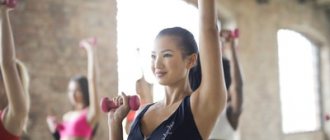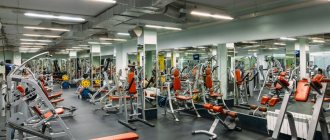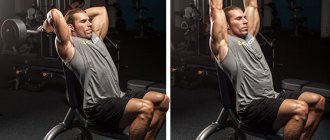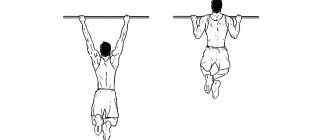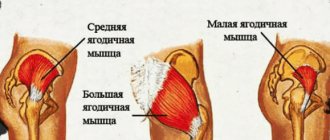Finally, you decided to go to the gym. If this is your first time, then it won’t hurt to learn a few rules that will help you understand what’s what and not feel stupid among the regulars.
In this article, we have collected everything you need to know before starting a gym session for beginners and those who have returned after a long break.
Gym for beginners
We will start with descriptions of gym visitors so that you understand who you will meet on your first day at the gym and spend 5-8 hours a week next to them. They can be divided into several groups.
- "Muscle squad"
This group includes those people who believe that nothing is more important than muscles. These are mostly men who like to “pull iron.” They are easy to spot among other gym visitors - throughout the workout they admire themselves in the mirror and give advice to those who have been in the gym not so long ago. Their main goal in life is to look like the Hulk, and they are successfully moving towards this.
- "Dead and Loafers"
It seems that someone forced these people into training - for example, husbands or wives - because they have stopped fitting into their own trousers or are unhappy with their appearance because their trousers are falling off. They prefer to take lighter weights - they simply cannot handle heavy ones, or even sit on the bench. Thus, they become a constant object of ridicule from the “muscle squad”.
- "Gossips and Gossips"
This category includes mostly women, but occasionally men are included. For them, the gym is another place where they can gossip and talk about other people. Usually they gather in small groups and evaluate the people working nearby, laughing periodically.
- "Pretentious fashionistas"
This category includes pretty and toned ladies who come to the gym to stay in shape. They seem designed to make other women in the room feel bad in comparison. They become the object of adoration of both the “muscle squad” and the coaches.
- "Groaners"
The last group includes seemingly unremarkable and generally good people. It is difficult to classify them into any of the described categories, but as soon as they start to swing, it immediately becomes clear that they belong to this group, even if you are far from the gym. During classes, they make very loud primal sounds, which often frighten other visitors.
Is it possible to quickly build muscle in your arms?
Male beginners don't know how long to work out in the gym to get bigger arms. To do this, they spend a lot of time doing biceps and triceps exercises. But in order to properly pump up your arms, you need to comprehensively develop the entire muscular system of the body.
Professionals can train biceps and triceps no more than 2 times a week with a break of 3 days. In this case, the training can last about 15 minutes, otherwise the athlete will overtrain the muscles.
Beginners can conduct a lesson to develop their hands once a week. On other days, the biceps and triceps work when performing basic elements (barbell press, pull-ups on the horizontal bar, etc.).
In order to pump up your hands as quickly and correctly as possible, you need to pay attention to your technique. The athlete must feel the muscles he is working.
Proper triceps training involves performing the following movements: extension on the upper and lower blocks, barbell press (close grip), extension of the arm with a dumbbell on a bench in an inclined position, as well as from behind the head while lying down, etc. To develop biceps in the gym, perform dumbbell, barbell, or lat pulldown biceps curls.
If these conditions are met, within a month you will notice that the muscles have begun to stand out; they have not yet grown, but have become stronger. If you continue training and gradually increase the load, then after 2-3 months your arms will become noticeably more massive.
Important! The main muscle of the arms is the triceps, which is 35% larger than the biceps. If it is developed, then the arms become more massive, and basic exercises are easier.
Where to start at the gym for the first time
Now that we have figured out the types of people you can meet in the gym, let's move on to more important information. So, what does a beginner need to know before going to training for the first time?
No need to try to lose 5 kg in one day!
A common mistake made by beginners is overloading the body during the first lesson. Add more load every day, but you don’t need to train for four hours straight on the first day. It took you a while to gain the weight, so be prepared to take some time to lose those extra pounds. If you ignore this advice, you can easily get injured.
Make a plan before you go to the gym
The day before your first workout, make an exercise plan, but it’s better to take it not from your head, but from proven sources. They usually offer exercises that are easy to do and safe.
To learn more about how to start training correctly, what a novice bodybuilder needs to pay special attention to, you can read in the articles training for a novice bodybuilder, part 1 and part 2.
Warm-up
Don't even think about starting strength training exercises without first warming up. Dynamic stretching is one of the best warm-up options, including circles with shoulders and arms, bends and lunges.
Be sure to do a 15-minute warm-up. During training, take lighter weights to establish the correct technique for performing the exercises. Start by doing two sets of 10 reps on leg presses, then do two sets of 10 reps on the stepper. After that, move on to the upper body - 30 biceps curls, 30 triceps curls. You can perform fewer repetitions, the main thing is to make sure that there is an even load on each arm. Then do 15 crunches, but don't go all the way down to the floor. Finish your workout with 10 minutes of cardio of your choice.
Basic training rules for beginners
We recommend that you take the following points seriously:
- never skip a warm-up - without it, you expose your muscles, ligaments and bones to the risk of injury and damage;
- clothing should be as simple and functional as possible;
- the first training time should not exceed 40-45 minutes;
- for the first few months, do not train more than 2 times a week;
- consultations with a professional in the first week are mandatory;
- eat no later than 1.5-2 hours before training - protein and carbohydrate foods are preferable;
- after training (about 30-45 minutes) it is also better to eat to restore calorie consumption;
- Bring water with you (at least 1-1.5 liters) - you must drink during classes to prevent dehydration.
And a few words about class time. It is determined strictly individually depending on the characteristics of the organism. For some, the peak of physical activity occurs in the morning, while for others it is more comfortable to exercise in the evening.
Exercises for beginners
This is a set of exercises that are perfect for the first day in the gym and not for the next 2-4 weeks, so that the muscles, ligaments and joints get used to the load. Only after completing this program can you move on to basic exercises with a barbell such as deadlifts, squats and bench presses, which are so popular with beginners.
Remember! When you first visit the gym or after a long break, you should not immediately do heavy basic exercises. There is a very high risk of injury. First, we get involved, get used to power loads on machines and with light weights, and only then move on to the base.
| Exercises | Sets x Reps |
| Hanging Leg Raise | 2x15 |
| Crunches | 2x15 |
| Oblique crunches | 2x15 |
| Bench chest press | 2-3x10 |
| Lying dumbbell flyes | 2x12 |
| Seated dumbbell press | 2-3x10 |
| Standing Dumbbell Flyes | 2x12 |
| Wide grip vertical row | 2-3x12 |
| Horizontal row in a block machine | 2x12 |
| Hyperextension | 2x15 |
| Seated leg extensions | 2x15 |
| Leg press | 2-3x10 |
| Lying leg curl | 2x12 |
| Standing Calf Raises (Standing Calf Raises) | 2x15 |
| Standing biceps curl | 2x10 |
| Triceps on the block down | 2x12 |
You can start working out in the gym using three complex exercises, namely the bench press, deadlift and back squats, only after preparing the body for new loads. By the way, read the article about mistakes in squats with a barbell on your shoulders.
Eat something simple before your workout
An hour before going to the gym, eat something simple (consisting of a few ingredients) and easily digestible - food that will not upset your stomach. Remember, this is your first day, so there is no need to worry about a clear time schedule for eating before and after the end of your workout.
Share your daily goal with your friends
The easiest and most proven way to stay motivated to work is to share your plans openly, for example, on Facebook. You won't want to lose face in front of your friends, which will help you stay motivated and disciplined.
Get help from a friend or coach
You probably know at least one person who, as they say, “ate the dog” while training in the gym.
Ask him to bring you up to date and help you figure out what's what. However, this approach has a significant drawback - such a person will most likely rush to share too much at once, which can overwhelm and confuse you. Moreover, even if your friend knows how to correctly and gradually present important information regarding training, there is a chance that you will feel like an opponent in him or, on the contrary, you will feel weak and inexperienced against his background. A better solution would be to seek the help of a trainer, which is available in every gym. He will give you a tour and show you where the locker rooms, showers and halls for group training are located, as well as exercise equipment and equipment. Moreover, he will be happy to tell you how this or that exercise machine works and what muscles it is aimed at working.
However, it is better not to use the services of a personal trainer on your first trip to the gym, as personal trainers often push beginners too hard so that they don’t feel like their money is being wasted. This, in turn, increases the likelihood of injury and is absolutely not suitable for the first lesson.
Don't be afraid to ask
If you see other people working out in the gym, don’t be afraid to come meet them and find out what they are doing and what muscles they are training. Most will not refuse help and will willingly share information.
What to take with you to training
- Workout clothes should be comfortable and light. A T-shirt and shorts work well.
- Buy a spacious sports bag.
- Comfortable shoes are sneakers or sneakers.
- It is absolutely necessary to bring a bottle of water - under proper exertion you will be very thirsty.
- Gloves will help keep your hands free from blisters when lifting heavy weights, and will also provide a better grip on equipment without slipping.
- Also take a towel - you will need it to wipe off sweat from your body after exercise.
- Take a lock for the cabinet in which your bag and personal belongings will be stored.
- Many people also listen to music while working out, so you can try it by bringing your iPod with you.
Try everything
The key word is “try.” Listen to your body and choose the right exercises for you. Each workout should include more than three exercises for each muscle group - fortunately, you have plenty to choose from. Perform each new exercise in two sets of 12-15 repetitions. If during the second approach it seems to you that you have no strength left, then move on to the next exercise.
Keep a diary
The numbers don't lie. Measure your progress, but in the right quantities. For example, you can get rid of fat and build muscle - this means that the weight will remain the same, but you will get in shape (accordingly, focusing only on weight is a bad idea). Write down all the exercises you do, as well as the number of sets and reps you perform.
Recover properly
Congratulations, you have survived your first gym workout! Now you need to properly recover - this means having a nutritious snack within 30 minutes after training, for example, drinking a chocolate milkshake. Protein is also needed for recovery, but try to avoid foods high in fat. In general, the day after training, eat only nutritious and healthy foods (and always!).
How many repetitions to do
We've sorted out the exercises. The next question is: how many times should I do it? Let's say you come to the dumbbell row. You can do 10 kg biceps curls 15 times, but 15 kg only eight times. Which is better? It’s best to immediately realize that your muscles can’t count. Then where did the persistent myth come from that a low number of repetitions increases strength, and high repetitions are about fat burning and relief?
The whole secret is in the time your muscles are under load. The optimal time at first is from 15 to 25 seconds per approach. This will most likely be in the 10-15 rep range. If this time is increased, then the number of calories burned will increase proportionally. If you follow a diet, this gives a slightly better result in burning subcutaneous fat. During the period of preparation for competitions and reaching peak form, professional athletes bring themselves to a critical state, when “loading” the body with heavy weights is either impossible or too dangerous for health. Therefore, when “drying” they work mainly with small weights, and in order for the muscles to receive sufficient load, it is necessary to increase the working time, that is, the number of repetitions.
First month in the gym
Now that you have a little experience, you can move on to more serious training. Strength training helps you achieve many goals - whether it's building muscle, burning fat, or increasing your overall performance. The selection of weights and exercises depends on the goal you are pursuing. Below are some general recommendations.
- If you want to build muscle mass, take heavier weights. Good weights and slow exercises are the key to building the body of your dreams. The optimal number of repetitions per approach is 4-8.
- If you want to lose weight, do more repetitions. In order to lose weight, you need to do more repetitions with light weights. The optimal number of repetitions per approach is 10-12.
- If you want to increase your overall performance, engage your whole body. Exercising specific muscle groups does not increase overall performance, so periodically perform exercises that involve the maximum number of muscles, such as push-ups.
- Don't forget about exercises for the core muscles. Exercises for the core muscles - the abs and lower back - are necessary in order to build a solid “foundation” for performing other exercises.
- Stick to a certain routine. Set your own routine and follow it - for example, five days of training alternating arms, back and shoulders, legs, chest and abs, then one day of aerobic exercise. It is important to get used to your program and not waste time in the gym thinking about which exercise to do next.
Core muscles
This information will give you a general idea of the main muscles of the human body that need to be trained:
- Biceps – trained with arm pull-ups and weighted arm curls
- The triceps are responsible for the bulk of the muscle mass in your arms, so if you only train your biceps, you're wasting your time.
- The pectoralis muscle is the chest, trained with bench presses and push-ups.
- Back muscles - include several muscle groups, which, along with the leg muscles, form the largest muscles of the human body
- Deltoid muscles - shoulder muscles
- Rectus and oblique abdominal muscles - trained by twisting, bending and exercises for the muscles of the center
- Gluteal muscles – trained by squats and lunges
- Quadriceps are thighs that should not be neglected, as they stimulate the production of chemical compounds necessary for building muscle mass.
- Hamstring muscles - trained by leg curls
- Calf muscles and forearm muscles - they are quite difficult, but need to be trained
“Beneficial” and “harmful” pain
It is important to be able to distinguish between “helpful” pain, which occurs in the muscles after strength training and lasts one or two days, from “harmful” pain, which lasts several days and may indicate an injury. If the latter is your case, then you should not postpone your visit to the doctor.
Strength training is usually safe, but if you don't exercise properly, you can damage something. This is why it is recommended to start with light weights to establish the correct technique.



